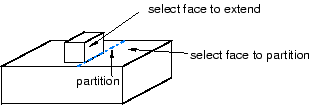Context:
Extending a face is analogous to creating an infinite plane that is
coincident with that face.
Abaqus/CAE
creates a partition wherever this infinite plane slices the selected faces you
are trying to partition, as shown in the following figure:

If the infinite plane cannot intersect any of the selected faces,
Abaqus/CAE
displays an error message. The extended face need not belong to the same part
as the faces to be partitioned; for example, in the
Assembly module
you can partition the face of one part instance by extending the face of a
second.
Abaqus/CAE
displays an error message if the part or assembly contains only one face.
From the main menu bar, select
.
The Create Partition dialog box appears.
Abaqus/CAE displays prompts in the prompt area to guide you through the procedure.
From the Type radio buttons at the top of the
dialog box, choose Face.
The Method list displays the methods that you
can use to partition a face.
From the list of methods, select Extend another
face.
Select the faces to partition. You can use a combination of drag
select,
ShiftClick,
CtrlClick, and
the angle method to select more than one face to partition. For more
information, see
Selecting objects within the current viewport.
Abaqus/CAE
highlights the selected faces.
Select the face whose extension creates the desired partition.
Abaqus/CAE
highlights the selected face.
In the prompt area, click Create Partition.
Abaqus/CAE
creates the partition.

 tool, located with the partition face tools in the module
toolbox. For a diagram of the partition tools in the toolbox, see
tool, located with the partition face tools in the module
toolbox. For a diagram of the partition tools in the toolbox, see